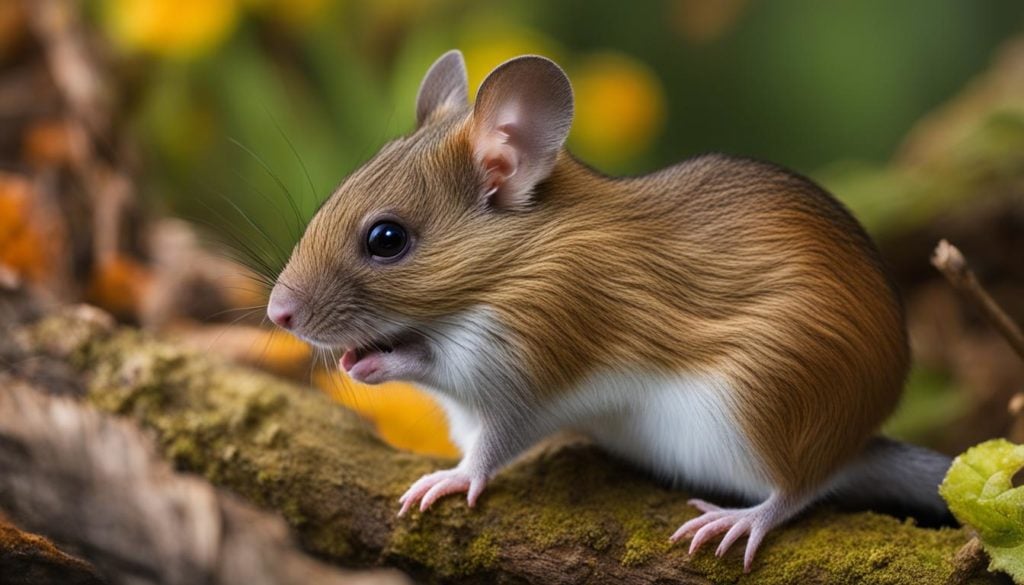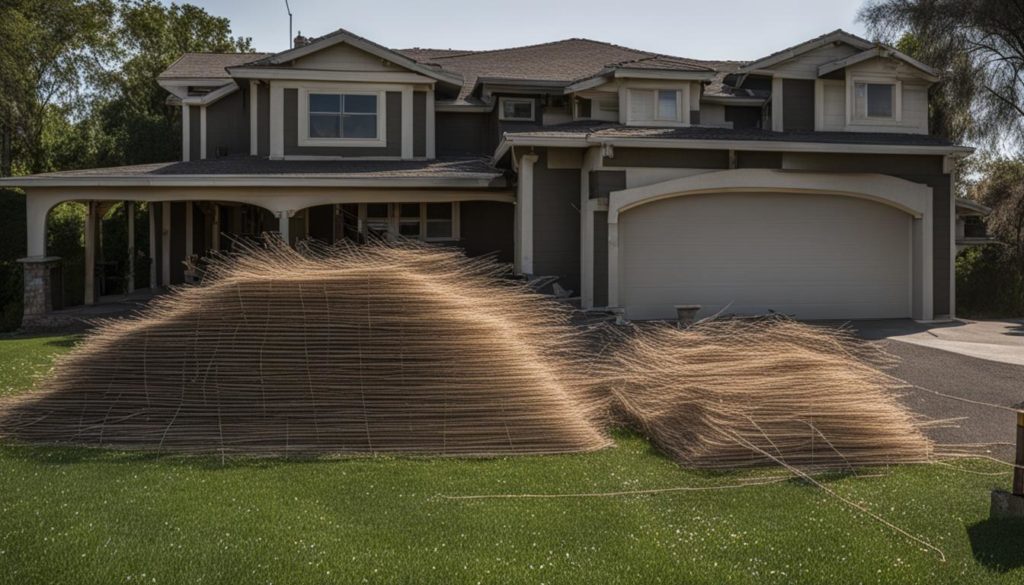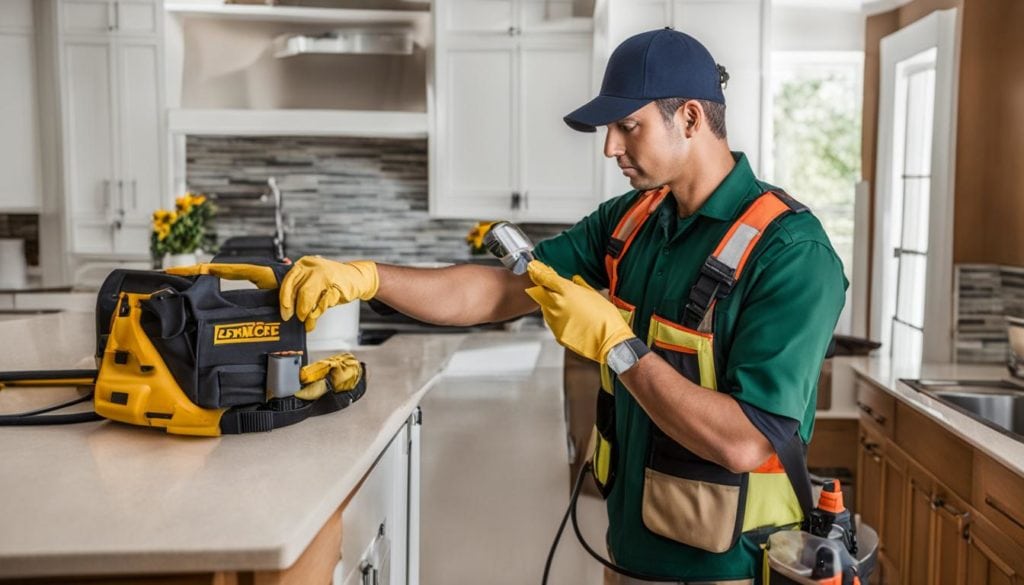Welcome to our guide on rodent trapping strategies, mouse control methods, and DIY rodent extermination. Dealing with rodents can be frustrating, but you can achieve a pest-free home with the right techniques.
Get rid of annoying rodents with a good plan. It should have three parts:
1. Close their entryways with caulk or wire mesh.
2. Keep food in airtight containers and clean pet bowls well.
3. Place traps where there are signs of mice or rats. Use snap traps for fast results or humane traps if you like.
Sticking to this plan is important for keeping your home rodent-free.
Next, we’ll talk about how keeping them out and cleanliness help. We’ll also discuss how natural predators can control the number of rodents.
Key Takeaways:
-
Use exclusion and sanitation tactics to keep rodents out and eliminate rodent attractions.
-
Seal entry points and eliminate sources of food and water to prevent rodent infestations.
-
Identify the specific rodent species to tailor your trapping and removal methods.
-
Choose the right traps and baits for effective control based on the level of infestation.
-
Implement rodent-proofing measures such as sealing entry points and elevating storage.
Preventing Rodent Infestations
Preventing rodent infestations is crucial in maintaining a pest-free home. Taking proactive measures to eliminate rodent access points and attractions can help keep these unwanted pests at bay.
Seal Entry Points
To stop rodents from getting into your house, first, block all entry points. Look for cracks or holes around your house. These can be near cabinets, sink pipes, or places where utilities come in. Use caulk or steel wool to fill these gaps. This stops rodents from entering.
Eliminate Rodent Attractions
Another key aspect of rodent prevention is to eliminate potential attractions that may draw them into your home. Keep food in tightly sealed containers, ensuring that there are no crumbs or spills left behind. Clean up pet food and water bowls after each mealtime and store them in a secure area. Proper waste disposal is also essential, as rodents are attracted to garbage. Make sure your trash bins have tight-fitting lids and empty them regularly.
Maintain Outdoor and Indoor Cleanliness
Keeping your outdoor areas clean and well-maintained can also deter rodents from nesting nearby. Avoid planting ivy, as it can provide a hiding place and easy access for rodents. Trim shrubs and trees away from your home’s exterior to limit potential entry points. Indoors, encase food items in sealed containers and regularly clean up any spills or food debris. Repair leaky pipes and fix any moisture issues to eliminate water sources that may attract rodents.
By taking these prevention measures, you can greatly reduce the risk of rodents and keep your home pest-free.
Identifying Rodent Species

If you’re dealing with a rodent infestation, it’s important to identify the specific species you’re dealing with. Common rodent species include mice, rats, and squirrels, each with their own unique behaviors and habits. By understanding the characteristics of these rodents, you can tailor your trapping and removal methods for more effective control.
Mice are small rodents that are typically 2-4 inches in length. They have a pointed nose, large ears, and a thin, scaly tail. They are skilled climbers and can fit through very small openings. Mice are known for their rapid breeding capabilities, so it’s important to act quickly if you suspect a mouse infestation.
Rats, on the other hand, are larger rodents that can grow up to 12 inches in length. They have a more robust body, blunt nose, and a hairless tail. Rats are excellent swimmers and can often be found in sewers and other water sources. They are known for causing structural damage by gnawing through materials like wood and wires.
Squirrels are also common rodents, particularly in outdoor areas. They have a distinctive bushy tail, sharp claws, and are excellent climbers. Squirrels can cause damage to gardens and homes by digging in lawns and attics. It’s important to address squirrel infestations promptly to prevent further damage.
Table: Comparison of Common Rodent Species
| Species | Size | Physical Characteristics | Behavior |
|---|---|---|---|
| Mice | 2-4 inches | Pointed nose, large ears, thin tail | Skilled climbers, rapid breeders |
| Rats | Up to 12 inches | Robust body, blunt nose, hairless tail | Excellent swimmers, causes structural damage |
| Squirrels | Varies by species | Bushy tail, sharp claws | Excellent climbers, digs in lawns and attics |
To effectively control rodents in your home or property, it’s crucial to know exactly which species you’re dealing with. This could be mice, rats, or squirrels. Knowing their specific characteristics and behaviors helps in setting up targeted control strategies. These strategies are more likely to work in managing and preventing rodent infestations.
Traps and Baits for Effective Control
To control rodents at home, traps and baits work well. There are various traps, each with pros and cons. Snap traps catch mice and rats efficiently. They snap shut fast when a rodent triggers them, offering a quick, humane kill. These traps are simple to use. Place them where you see a lot of rodents, like along walls or by entry points.
If you prefer a more hands-off approach, electronic traps are a great option. These traps use a combination of bait and an electric shock to quickly dispatch rodents. Electronic traps are efficient and can catch multiple rodents before needing to be emptied. They are also safe to use around children and pets, as they are designed to prevent accidental shocks.
For those who want to live trap rodents and release them back into the wild, live animal traps are the way to go. These traps allow you to safely capture rodents without harming them. Once caught, you can release the rodents far away from your home to prevent them from returning. Live animal traps are a humane option for those who don’t want to harm rodents but still want to remove them from their property.
When it comes to baits, there are several options available. One popular choice is peanut butter. Rodents are attracted to the scent of peanut butter and will eagerly take the bait. Other common baits include cheese, chocolate, and dried fruit. It’s important to place baits strategically near traps to increase the chances of catching rodents. Remember to check and refill the traps regularly to ensure continued effectiveness.
Comparison of Rodent Traps
| Trap Type | Advantages | Disadvantages |
|---|---|---|
| Snap Traps | Quick and humane kill, easy to set up | May not be suitable for larger rodents |
| Electronic Traps | Efficient, can catch multiple rodents, safe for children and pets | Requires batteries or electricity |
| Live Animal Traps | Humane, allows for release of captured rodents | Requires regular monitoring and release of trapped rodents |
It’s important to note that traps and baits should always be used in a safe and responsible manner. Keep traps out of reach of children and pets, and follow the manufacturer’s instructions for proper use. Regularly inspect and clean the traps to maintain their effectiveness. Use traps and baits to control and eliminate rodent infestations in your home.
Rodent-Proofing Your Home

In order to maintain a rodent-free home, it is essential to take proactive measures to rodent-proof your living space. By following these effective strategies, you can minimize the risk of rodents entering your home and causing havoc.
Elevate Storage and Eliminate Clutter
Elevating storage items is crucial for rodent-proofing, especially in basements and garages. Keep items at least one foot off the ground. This makes it difficult for rodents to reach stored goods. Also, removing clutter is important. Clutter offers rodents places to hide. Organize and clean your storage areas. This reduces places where rodents can nest.
Seal Entry Points with Metal Mesh
Check your home for any spots rodents might enter. Look for cracks, crevices, or holes outside your house. Cover these with metal mesh or hardware cloth. These materials are tough. They stop rodents from chewing through and keep them out effectively.
Maintain a Clean Outdoor Environment
Making your home unattractive to rodents is crucial. Cut back tree branches near your house. They can act as bridges for rodents. Clean your outdoor spaces regularly. Remove debris and properly dispose of waste. Do not let ivy or dense plants grow. They offer hiding places for rodents.
| Benefits of Rodent-Proofing Your Home |
|---|
| Prevents costly damage to property |
| Reduces the risk of disease transmission |
| Protects your food and belongings from contamination |
| Ensures a safe and hygienic living environment |
“Rodent-proofing your home is an ongoing process that requires consistent effort and maintenance. By implementing these strategies, you can greatly reduce the risk of rodent infestations and enjoy a pest-free living environment.”
This lets you have a home without pests. Start today to protect your home from unwanted guests!
Professional Pest Control Services

If you’re dealing with a bad or ongoing rodent problem, think about hiring professional pest control services. These experts are trained to get rid of rodents safely and well, which means you won’t have to worry about pests anymore. Make sure to choose companies that are certified by Ecowise or GreenShield. They use methods that are good for the environment.
Professionals often use the Integrated Pest Management (IPM) strategy. IPM is a complete plan that tries to prevent, watch, and control pests with as few chemicals as possible. This plan helps the environment by tackling the root cause of the pest problem and using specific solutions. It’s more lasting and eco-friendly than old pest control ways.
Hiring professionals has its benefits. They’re good at finding out how bad the pest issue is and spotting where pests are getting in. It can be hard to find these spots yourself. They also give advice on how to close these entry points. Plus, they can find and get rid of nests or colonies, helping avoid future problems.
Benefits of Professional Pest Control Services
-
Effective and targeted solutions for rodent control
-
Expertise in identifying entry points and nesting areas
-
Environmentally friendly methods, such as Integrated Pest Management
-
Long-term prevention strategies
-
Ecowise or GreenShield certified options for a more sustainable approach
Pest control professionals can effectively handle rodent infestations and keep your home safe and pest-free. – Pest Control Expert
| DIY Pest Control | Professional Pest Control |
|---|---|
| Requires time and effort | Efficient and time-saving |
| May not be effective for severe infestations | Offers solutions for all levels of infestation |
| May not have access to professional-grade products | Uses advanced and targeted products |
| Risk of improper use of chemicals | Safe and responsible use of pest control products |
Overall, professional pest control services provide a comprehensive and tailored approach to rodent control. Consulting with a professional is a wise choice if you have a stubborn infestation or want a long-term solution.
Conclusion
Congrats! You made it to the end of our rodent trapping guide. Follow our tips and techniques to tackle your rodent problem. This will help keep your home rodent-free.
Rodent control is continuous. Do regular checks and use proactive methods to keep your home pest-free. Stay alert and act quickly on any rodent signs to prevent infestations.
Use preventive steps like sealing up holes, removing attractions for rodents, and choosing correct traps and baits. This ensures a rodent-free space. If rodents still bother you or the situation worsens, ask for help from pest control professionals. They offer expertise and more pest management options.
With effort and effective strategies, you can manage rodent control and have a pest-free home. Start now to stop the rodents!
FAQ
How can I prevent rodent infestations?
To stop rodents from getting into your home, block any holes or gaps. Store food in containers with tight lids. Clean up after your pets, removing food and water bowls when not in use. Dispose of garbage properly. Avoid growing ivy because it can attract rodents. Keep your garden and yard tidy by trimming plants. Inside, put food in sealed containers. Keep your house clean. Fix any pipes that are leaking.
How do I identify the type of rodents infesting my space?
Common rodent species include mice, rats, and squirrels. Identifying the specific rodent species is essential for effective control strategies. Each species has different behaviors and habits, so understanding their characteristics will help tailor trapping and removal methods accordingly.
What traps and baits can I use for rodent control?
Traps and baits are effective tools for rodent control. Different types of traps include snap traps, electronic traps, and live animal traps. Bait stations can also be used to deliver poison to rodents. Place traps and baits in areas with high rodent activity for optimal results.
How can I rodent-proof my home?
To keep rodents away, block their entry points with metal mesh or hardware cloth. Store firewood and clutter away from your house. Also, keep items stored off the ground in basements and garages. These actions will prevent rodents from nesting and entering your home.
When should I seek professional pest control services for rodent infestations?
If a rodent infestation is severe or persistent, it may be necessary to seek professional pest control services. Pest control experts have the knowledge and experience to handle rodents safely and effectively. Look for companies that are Ecowise or GreenShield certified and familiar with Integrated Pest Management techniques.
How can I maintain a rodent-free environment?
Maintaining a rodent-free environment requires a combination of prevention, identification, and treatment. By implementing effective rodent trapping strategies, sealing entry points, and eliminating rodent attractions, you can prevent and manage rodent infestations. Regular inspections and proactive approaches to rodent control are key to success.
Source Links

Welcome to micegoneguide.com, your go-to resource for eliminating rats and mice. Say goodbye to rodent infestations with our expert tips and strategies. Visit us now and reclaim your space!

